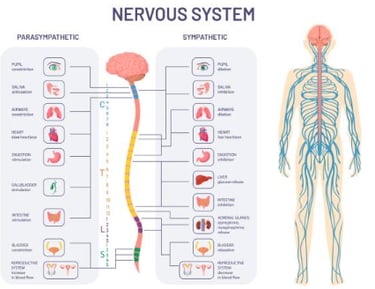What’s All the Fuss About the Vagus Nerve?


You have a central communication system running from your brain to your large intestine that carries signals/information among your gut, brain, and heart. It plays a major role in both mental and physical health.
The vagus nerve, or left and right vagal nerves, are the main structural system of your parasympathetic nervous system, which helps keep basic functions of your body (such as breathing, hormone regulation, digestion, heart rate, blood pressure, and immune system) working properly.
The word vagus comes from the Latin root meaning “wandering” and that’s what the vagus nerve does, connecting 100,000 parasympathetic nerve fibers to the brain and multiple organs, including your heart, lungs, liver, spleen, stomach, intestines, and kidneys.
Thus, it is essential to monitor and protect the health of the vagus nerve… not doing so could put you at a greater risk of gastrointestinal issues, heart disease, depression, and anxiety.
Generally speaking, what is good for your heart, brain, and gut is also good for your vagus nerve; thus, focus on a healthy diet, daily movement, breathwork, quality sleep, and meditation for maintaining the vagus nerve.
Vagal tone refers to the health of the vagus nerve, with high tone being associated with calm and less anxiety, reduced inflammation, as well as better emotional, physical, and mental well-being.
The rest of this article looks at ways to improve your vagal tone, but be sure to check with your doctor before starting any exercise regimen.
Strategies for Improving Vagal Tone
1. Eliminate Sugar From Diet. Excess sugar is a known toxin for the body, and that includes the vagal nerve, which helps regulate blood sugar and has a role in insulin resistance. Refined sugar is an inflammatory food that negatively affects physical health (including weight gain) as well as mental health (because of its detrimental impact on brain chemistry). The body has no need or requirement for any consumption of refined sugars, so eliminating these sugary foods from your diet is a major strategy for improving vagal tone.
2. Finding Your Best Diet. As I stress in my book, The Healing Revolution Diet, if you want optimal health and a strong digestive system then you must only eat foods that do not upset your stomach. Gluten and dairy are two common digestive stressors, but certain plants also contain antinutrients that some are sensitive to, such as lectins, goitrogens, phytates, and oxalates. But this advice also includes eliminating as many unhealthy ultra-processed foods as possible while cooking more from scratch. Find the foods that make your gut happy, because a happy gut is important to a healthy vagal tone.
3. Mixed Intensity Aerobic Exercise. Vagal tone is measured by tracking your heart rate variability (HRV), which is the time between each beat per minute and how much variation and time. By partaking in interval and endurance training, you are exercising your heart and strengthening your vagal nerve function. Walking is a wonderful exercise, but the key is working out hard enough to get out of breath, so mix up times of regular walking with times of speed walking.
4. Deep, Restorative Sleep. Sleep is essential for all healthy functions, including the vagal nerve. It’s not just about getting one good night’s sleep or catching up on sleep on your days off… it is essential for good vagal tone that the connection with your circadian rhythm – the cyclical 24-hour period of human biological activity – is strong, steady, consistent. Cool and darken your bedroom and outlaw all screens/devices and wifi.
5. Positive Social Connections and Physical Touch. Because of its connection with the parasympathetic nervous system, the power of loving connections, touch, and hugs work like magic in improving vagal tone. Find and build your tribe: your community of people who love and support you… and meet regularly, with long, loving hugs of at least 20 seconds, but some experts say hugging longer has even greater benefits.
6. Rhythmic Nasal Breathing Exercises and Deep, Slow Breathing. Most of us pay so little attention to our breath and breathing, and yet breathwork is so restorative for the body, gut, and mind. Practice alternate nostril breathing and diaphragmatic belly breathing (with a deep inhale through the nose and a long, slow exhale through the mouth) for stimulating the vagus nerve, slowing heart rate, and reducing blood pressure.
7. Humming, Chanting, and Singing… Even Gargling. Lifting your voice to the tones of uplifting music – because of the power of your vocal cords – strengthens vagal tone. Some experts say even just listening to soothing music can also be good for vagal tone. Don’t just sing in the shower; keep music playing and when a favorite song starts, join in!
8. Meditation, Prayer, Relaxation Techniques. Finding time each day for quiet reflection for at least 10-15 minutes works wonders for vagal tone. You can do a specific meditation, picturing vagal tone improving as you meditate, but experts suggest that simply sitting quietly in some reflective technique – prayer or meditation – works just as well. Make this part of your daily schedule for the greatest impact.
9. Intermittent Fasting. Have you tried this trendy health technique – which also helps stimulate vagal tone? The goal of intermittent fasting is to give your digestive system a rest; for example, the easiest method is to stop eating by 9 pm and skip breakfast the next morning, breaking the fast at lunch. Intermittent fasting also improves blood sugar regulation, sharpens cognitive functioning, helps heart function, induces cell repair, reduces inflammation and oxidative stress, and increases fat burn.
10. Laughter. Who doesn’t know the line about laughter being the best medicine, but guess what? Laughter is a powerful tool for calming the parasympathetic nervous system and improving vagal tone, and you only need about 10 minutes of laughing – so turn on that favorite sitcom, watch your favorite comedian, or just share funny stories. Remember not to suppress those hardy laughs because they stimulate diaphragmatic breathing, which helps healthy vagal tone.
Final Thoughts on the Vagus Nerve and Vagal Tone
The main method for measuring vagal tone is by tracking heart rate variability (HRV), which is the time between each beat per minute, and how much variation and time. There is no magic number for HRV and vagal tone, but the higher the HRV, the healthier the vagal nerve.
Some other suggestions for improving vagal tone include cold exposure – anything from splashing cold water on your face to cold showers to cold plunges – as well as reflexology massages and chiropractor adjustments.
Most of the strategies for improving vagal tone are fairly easy to implement, but for the exercise and fasting suggestions, be sure to check with your doctor before starting.
Finally, remember that past trauma and chronic stress also affect the vagus nerve, so these are also important to work on to increase vagal tone.
Vagus Nerve Book Recommendation
Healing Through the Vagus Nerve: Improve Your Body’s Response to Anxiety, Depression, Stress, and Trauma Through Nervous System Regulation, by Amanda Armstrong, MA


